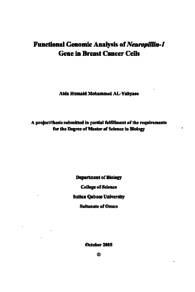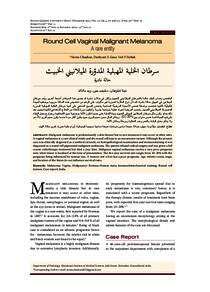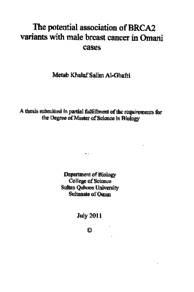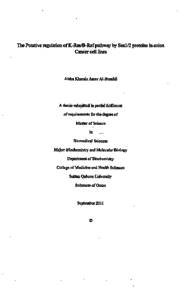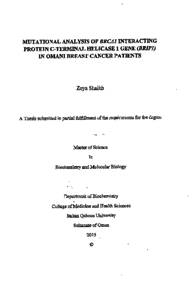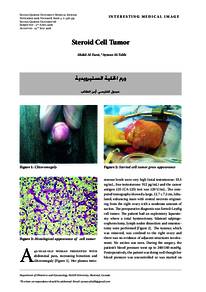وثيقة
Functional genomic analysis of neuropillin-1 : gene in breast cancer cells
الناشر
Sultan Qaboos University
ميلادي
2015
اللغة
الأنجليزية
الموضوع
الملخص الإنجليزي
The high expression level of Neuropillin-1 (NRP1) is correlated with more advanced stages of metastasis and tumor progression in many epithelial carcinomas including breast cancer. However, the exact molecular mechanism by which it promotes breast cancer cell tumorigenicity is not well defined yet. NRP1 is a multifunctional protein that acts as a co-receptor for a number of growth factors including vascular endothelial growth factor VEGF-165 and transforming growth factor beta (TGFB1). In this study, we hypothesized that NRP1 can be a potential biomarker for breast cancer and might be involved in the Epithelial to Mesenchymal Transition (EMT) pathway. We investigated the functional role of NRP1 in three representative breast cancer cell lines in vitro. This was achieved by two main approaches; overexpressing and knocking down NRPI. NRP1 was overexpressed in the breast cancer cell lines MCF-7 and BT-474 known to express a moderate and small amount of the corresponding protein, respectively. The full length NRPI cDNA as well as the cDNA encoding the soluble form (S12NRPI) were cloned in PPTuner IRES2 plasmid. Moreover, we stably knocked down NRPI in MDA-MB-231 (expresses excessive amount of NRPI) cells using two different shRNA sequences targeting regions of this gene. Western blot results showed that NRP1 was significantly overexpressed in BT-474 compared to MCF-7 cells upon NRPI PPTuner (full length cDNA construct) transfection. In contrast, a significant reduction in NRP1 expression in MDA-MB-231 cells was observed upon transfection with shNRP1-06-1 plasmid. The proliferation alamarblue assay results showed unexpected trend of reduction in cellular proliferation in both transfected cells (MCF-7pPTuner and BT-474 PPTuner) whereas, a significant reduction in cellular proliferation of MDA-MB-231 cells was observed upon transfection with the same plasmid that cause down regulation of NRP1 expression in these cells. The expression level of NRP1 and some other related genes in the EMT and angiogenesis pathways (VEGF, TGFB1, ZEBI, PLGF, PDGF-A, PDGF-B, FGFRla and FGFRIB) were checked using RT-PCR. The results
ated that mRNA gene expression of NRP1 and TGF1 showed a trend of decrease in expression between three cell lines in which MDA-MB-231 express high levels of the gene followed by the MCF7 and BT474 respectively. The expression of all the other checked genes except PDGFB was significantly higher in MDA-MB-231 cells compared to the other two non-metastatic cell lines. Our findings highlight the possible involvement of NRP1 in the EMT pathway since its expression level was proportionally increasing in the more tumorogenic cells and had similar pattern to those expressed levels of TGF-B and ZEB-1. Achieving complete silencing of its expression might inhibit breast cancer cell proliferation and therefore, it may serve as a useful prognostic biomarker for breast cancer diagnostics and a good target for an effective cancer therapy.
الوصف
Thesis
المجموعة
URL المصدر
الملخص العربي
رتبط مستوى التعبير العالي من Neuropillin-1 (NRP1) بمراحل أكثر تطوراً من ورم خبيث وتطور الورم في العديد من سرطان الظهارة بما في ذلك سرطان الثدي. ومع ذلك ، فإن الآلية الجزيئية الدقيقة التي تعزز بها تورم الخلايا السرطانية في الثدي لم يتم تعريفها بشكل جيد حتى الآن. NRP1 هو بروتين متعدد الوظائف يعمل كمستقبل مشارك لعدد من عوامل النمو بما في ذلك عامل نمو بطانة الأوعية الدموية VEGF-165 وتحويل بيتا عامل النمو (TGFB1). في هذه الدراسة ، افترضنا أن NRP1 يمكن أن يكون علامة بيولوجية محتملة لسرطان الثدي ويمكن أن تشارك في المسار الظهاري إلى الانتقال إلى الوسيط (EMT). نحن التحقيق في الدور الوظيفي لل NRP1 في ثلاثة خطوط خلايا سرطان الثدي التمثيلية في المختبر. وقد تحقق ذلك من خلال نهجين رئيسيين ؛ overexpressing وطرق NRPI. تم التعبير عن NRP1 في خطوط خلايا سرطان الثدي MCF-7 و BT-474 المعروفة بالتعبير عن كمية معتدلة وصغيرة من البروتين المقابل ، على التوالي. تم استنساخ كامل طول NRPI [كدنا] وكذلك [كدنا] ترميز شكل قابل للذوبان (S12NRPI) في PPTuner IRES2 البلازميد. علاوة على ذلك ، قمنا بتثبيط NRPI بشكل ثابت في MDA-MB-231 (يعبر عن كمية زائدة من خلايا NRPI) باستخدام تسلسلين shRNA مختلفين يستهدفان مناطق من هذا الجين. وأظهرت نتائج لطخة غربية أن NRP1 كان overexpressed بشكل ملحوظ في BT-474 مقارنة مع خلايا MCF-7 على ترنسفكأيشن NRPI PPTuner (بناء كامل [كدنا]). في المقابل ، لوحظ انخفاض كبير في تعبير NRP1 في خلايا MDA-MB-231 عند ترنسفكأيشن مع البلازميد shNRP1-06-1. أظهرت نتائج اختبار انتشار alamarblue اتجاها غير متوقع لخفض التكاثر الخلوي في كل من الخلايا المنقولة (MCF-7pPTuner و BT-474 PPTuner) ، بينما لوحظ انخفاض كبير في التكاثر الخلوي لخلايا MDA-MB-231 عند ترنسفكأيشن مع نفس البلازميد التي تسبب أسفل تنظيم التعبير NRP1 في هذه الخلايا. تم فحص مستوى التعبير عن NRP1 وبعض الجينات الأخرى ذات الصلة في مسارات EMT وعائية الأوعية (VEGF ، TGFB1 ، ZEBI ، PLGF ، PDGF-A ، PDGF-B ، FGFRla و FGFRIB) باستخدام RT-PCR. النتائج
ated أن التعبير الجيني mRNA لـ NRP1 و TGF1 أظهر اتجاه انخفاض في التعبير بين ثلاثة خطوط خلوية يعبر فيها MDA-MB-231 عن مستويات عالية من الجين تليها MCF7 و BT474 على التوالي. كان التعبير عن جميع الجينات الأخرى التي تم فحصها باستثناء PDGFB أعلى بكثير في خلايا MDA-MB-231 مقارنة بخطي الخلايا غير المنتقيتين الأخريين. النتائج التي توصلنا إليها تسليط الضوء على احتمال تورط NRP1 في مسار EMT لأن مستوى تعبيره كان يزداد بشكل متناسب في الخلايا الأكثر تورمًا وكان له نمط مشابه لتلك المستويات المعبر عنها من TGF-B و ZEB-1. إن تحقيق إسكات كاملة للتعبير عنها قد يمنع تكاثر خلايا سرطان الثدي ، وبالتالي ، قد يكون بمثابة علامة بيولوجية تنبؤية مفيدة لتشخيص سرطان الثدي وهدفًا جيدًا لعلاج سرطان فعال
ated أن التعبير الجيني mRNA لـ NRP1 و TGF1 أظهر اتجاه انخفاض في التعبير بين ثلاثة خطوط خلوية يعبر فيها MDA-MB-231 عن مستويات عالية من الجين تليها MCF7 و BT474 على التوالي. كان التعبير عن جميع الجينات الأخرى التي تم فحصها باستثناء PDGFB أعلى بكثير في خلايا MDA-MB-231 مقارنة بخطي الخلايا غير المنتقيتين الأخريين. النتائج التي توصلنا إليها تسليط الضوء على احتمال تورط NRP1 في مسار EMT لأن مستوى تعبيره كان يزداد بشكل متناسب في الخلايا الأكثر تورمًا وكان له نمط مشابه لتلك المستويات المعبر عنها من TGF-B و ZEB-1. إن تحقيق إسكات كاملة للتعبير عنها قد يمنع تكاثر خلايا سرطان الثدي ، وبالتالي ، قد يكون بمثابة علامة بيولوجية تنبؤية مفيدة لتشخيص سرطان الثدي وهدفًا جيدًا لعلاج سرطان فعال
قالب العنصر
الرسائل والأطروحات الجامعية

